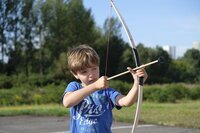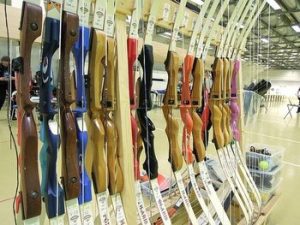
Whether you’re chasing a high-power bow for optimal accuracy or a simple, easy-to-shoot beginner’s bow, there’s something for everyone.
Researching some recurve bow tips from a credible source is a smart idea.
Finding the right choice among the the many bows that are available can be a tough challenge. We’ve selected a number of the better options for you to check out here.
You should start your search for a recurve bow that fits your style, strength, whether you’re left or right handed, what you’re going to use it for and your budget range.
This article will help you to increase your knowledge about these bows so that you’ll know exactly the right recurve bow to purchase, based on the knowledge you will have absorbed.
You will learn –
- The best recurve bow for a beginner
- Best recurve bow for target shooting
- Best value recurve bow for your money
- Size recommendations for recurve bows
A Recurve Bow That's Ideal for Learners
The TopArchery Takedown Recurve Bow is an excellent example of how you can enjoy a high-quality bow at a budget-friendly price and, it’s an ideal recurve bow for learners.

- 20 pounds (9.07 kg)
- 30 pounds (13.61 kg)
- 40 pounds (18.14 kg)
This bow can be assembled in a matter of minutes. It comes with a double arrow rest designed for left-handed and right-handed people.
The bow is 57 inches (144.78 cm) long with a brace height of 9.4 inches (23.88 cm). You can take advantage of the ergonomic grip as you learn the basics of archery.
The riser is made of flexible, durable nylon fiber, whereas the rest of it is made from epoxy. It doesn’t use low-end, cheap, flimsy wood like most beginner bows.
If you’re looking for a great recurve bow that won’t cost you an arm and a leg, then TopArchery has your pick. The company offers a 100% satisfaction guarantee. If you have any issues, you can lodge a complaint for a quick reply from a responsive customer service team. They also have a wide selection of recurve bows for experienced bowmen.
The Fabulous Archery Recurve Bow
The bow and arrow is one of the oldest hunting toolset used by mankind. The first, apart from the humble rock, was very definitely a rudimentary spear: a rod with a sharpened stone or shell affixed to one end. We can invisage some ingenious ancestor of ours devising a means to shoot with a spear while avoiding having to approach the game.
As a result, the spear was transformed into a streamlined arrow.
Some refinement was required after the firdst attempts. After some testing, it was discovered that the length of the string affected the distance that the arrow was able to travel. For our imaginary ancestor, the further the arrow travels means further means increased safety.
Now, the design of the bow was based around the string’s length. As would be expected, the ultimate result of all this testing was a harmonious relationship between the string length, accuracy versus distance ratio, and an archer’s average strength.
For this exercise let us imagine the archer would prefer to be 680 feet away from a mammoth, this would mean the string would have to be extremely long. This would result in a bow that is what too lengthy and basically, totally impractical.
So We Have a Problem!
Thankfully the solution was discovered before the mammoths ate too many of our forefathers. The archery recurve bow is what it’s referred to today.
Essentially, the recurve bow has been constructed with an outward arc on each of its edges. Consider it this way: the archer stands with his bow at the ready, draws the string, and each end of the bow are pointing at the target, not at himself.
As a result, the archer can increase the tension on the bow and string, so he can shoot the arrow a greater distance.
In other words, the archer is now getting far better performance from his hunting equipment. And we’re now within striking distance of our target of 680 feet. Consider how crucial this was in the days when waring armies consistantly included only archers!
The recurve bow is the more common bow on the archery range than any other, both for competition and practise. Actually, this bow has become the ‘go to’ choice for archers and is the only bow authorised to be used in Olympic contests.
In the field of bow hunting, this particular bow is the one of choice. When a hunter is out in the woods hunting his prey, he must consider a variety of factors. Because every shot counts, he wants maximum power from his bow.
However, he needs to make sacrifices in bow length for two key reasons –
- He wants to keep his hunting gear as light as possible.
- When he’s stalking prey through thick brush a longer bow would impeded his progress.
When’s the Right Time to Upgrade Your Recurve Bow?
You’ve been shooting with a recurve bow for a long time, but it’s time to upgrade and try something new. Whilst it may be difficult to go with your old reliable bow because it has served you well for a long time, purchasing a new recurve bow is an exciting time
If you’ve owned your recurve bow for a while, you’re probably aware that a lot has happened in the world of bows since you last bought one. In recent years, new technology has been developed to assist make your shot cleaner, quicker, and with less vibration.
If you haven’t bought a recurve bow in a while, or if you were a teen when you did, make sure you obtain the correct size draw length so you can get the best from the one you pick.
Try out numerous brands of recurve bows before making your ultimate selection, even if your current recurve bow is still performing well. Bow producers tend to go through stages when they build high-quality bows for a long time, but then decide to modify their production technique, and sometimes their quality declines as a result.
Make sure you check out a few different models and read up on the most recent evaluations of the best choices on the market. This will provide you with a fair idea of what to expect from your new bow. When it comes to Recurve bows, as with many other things we purchase in life, we only ever get what we pay for.
Here’s a hot tip for recurve archers – a recurve bow that’s really inexpensive should be disregarded since there is generally a reason for anything being so cheap. A bow that suits your budget and demands at a reasonable price is typically your best choice, but if you have a large budget, go all out. There are some wonderful bows out there at the top of the pricing range.
Choosing The Perfect Recurve Bow For You
The recurve bow derives its namefrom the fact that the bow curves back, then back again (recurves). The string contacts a portion of each arm the bow when it is strung. The second curve runs counter to the bow’s natural curvature, giving the recurve bow more power.
Because of the extra energy provided by the curvature, a recurve bow has significantly more energy than a straight bow of similar length. This is useful for archers who would prefer to travel with a bow that is easier to carry through brush or in other situations where length is a concern.
How to Measure a Recurve Bow Length
The length of a recurve bow can vary from 48 to 70 inches. A standard target bow measures around 66 inches in length. It’s considered by the majority that, for the sake of stability, a recurve bow should be a minimum of 58 inches long.
The length of the bow you choose is mostly determined by the length of your pull. If your draw length is under 28 inches, consider a bow between 62 and 66 inches, and if the length of your draw length is greater than 28 inches, choose a bow from 66 and 70 inches in length.
Well all that’s good and well but how do I calculate the length of my draw?
The simplest method is to take the length of your arm span and multiply it by 2.5. Enlist the assistance of a buddy. Spread your arms out in front of you, palms facing front. Instead of extending out your arms, simply hold them out in front of you and turn your palms forwards.
Measure from the tip of one middle finger to the tip of the other middle finger with the assistance of a friend. Divide by 2.5 and your draw length is the result.
There are a few indicators that will assist you to determine if your measurement is correct. Your arm spread is nearly the same length as your height. Your arm spread is say 64 inches then you will be roughly 64 inches (or 5 feet 4 inches) tall.
You may double-check whether the size of the recurve bow is suitable for you when you go to buy one. If you have measured your arm spread accurately, the folks at the archery store will be able to tell you.
Is a Recurve Bow Good for Target Practice
There’s no doubt the SinoArt Takedown Bow is very accurate and a great bow for target practice.
You can choose between the left-handed or right-handed design. There’s a wide variety of sizes ranging from 30 pounds to 60 pounds (13.61 kg to 27.22 kg) in 5-pound (2.3-kg) increments. Regardless of the options that you choose, it’s very reasonably priced.

It comes with a wood riser, two bow limbs, 16 strands of string, a stringer, a fur rest pad, two string nocks, and a pair of string silencers.
All of these tools can be used to customize your bow’s appearance and functionality, optimizing the accuracy based on your style of archery.
This 58-inch (147.32 cm) bow only weighs 2.2 pounds (0.998 kg), so you don’t have to worry about being weighed down. The laminated exterior is perfect for long-lasting, durable playstyles. This bow is made specifically for hunting and target practice. Whether you’re sharpening your skills at the range or hunting for dinner, you can count on it.
Recurve Bow Target Shooting
In modern recurve bow target shooting contests all around the world, recurve archery is a popular choice. The traditional recurve bow is used in Olympic level competition. The archer holds his bow with the hand opposite his dominant eye when shooting Recurve Bow.
This hand is referred to as the bow hand, and the arm is referred to as the bow arm. The drawing hand is his opposite hand, which is in line with his dominant eye and is used to draw the bow’s string. This hand is also known as the string elbow or the bow holder.
‘Right Eye’ Dominant Archers
People with the right eye as their dominant eye carry their bow in their left hand and face the target on the left side. With their right hand, they draw the string and unleash the arrow. Some people aim with their right dominant eye by turning or tilting their heads. People that are dominant with their left hand do the reverse.
There are various steps to efficiently shooting an arrow with a recurve bow. The initial step is to get into the proper position. The target and the shooting line should be perpendicular to the archer’s body. He should have his feet shoulder-width apart. More advanced archers take a ‘open posture’
The leg that is furthest from the shooting line is positioned half a foot or a full foot length in front of the other in this posture. Every archer has a favourite posture.
Then There’s The Nock
The string is released and the bow is pulled down to a position where it is pointed to the ground while loading a recurve bow. The arrow’s shaft is resting on the arrow rest, which is located at the bow window. The bowstring is then inserted into the back of the arrow and ‘nocked’
The ‘nock’ is a little plastic portion of the arrow that has a V groove and is placed at the edge. The traditional arrow has three vanes and should be positioned so that one vane points away from the bow. This vane is sometimes referred to as a cock-feather or index fletch and comes in a variety of colours.
Holding Your Bow
The bow is held by the bow hand, while the string and arrow are handled by three fingers of the drawing hand, when in position. The arrow is placed between the index finger and the two fingers below it. The first or second joints of the fingers are commonly used to draw the string. After that, the bow is elevated.
The technique for rising and drawing is frequently done in one fluid motion and differs from archer to archer. The string is pushed back towards the face by the back muscles when the bow is raised, and it rests at an anchor point, which is commonly the corner of the mouth or chin.
From one shot to the next, this anchor point remains the same. The bow hand and arm should maintain a steady vertical position for the bow. Although the bow arm is stretched out towards the target, the elbow should be checked for hyperextension.
The string may snare and scrape the inside of the elbow or wrist as a result.
When the string is drawn, the archer’s stance should create an erect T. Most modern bows contain a mechanical clicker that lets the archer know when he or she has reached the correct draw length. The arrow is then liberated by releasing the sketching hand’s fingers.
Following the release, the archer should be aware of the bow’s rebound and follow through with his body. This could be a sign of flaws in his form or ability.
A Top Value Recurve Bow
If you’re hunting for a top value recurve bow you’ll love the Samick Sage Takedown Recurve Bow. This 62-inch (157.48 cm) bow has a 28-inch (71.12 cm) draw length, giving you the accuracy you need with a comfortable size that fits most people. You can choose from a left or right-handed bow and a size between 25 to 60 pounds (11.34 to 27.22 kg).

It’s made of laminated fiberglass, and you can change any of the parts to alter the performance and appearance.
Hardened maple limbs add to the natural look while boosting the structural integrity of the bow.
Each bow comes with 14 strands of dacron string, which is more than enough for any bowman. The smooth arrow rest allows the arrows to glide from the bow to the target without hindering the speed or accuracy. It’s as good as it gets when you’re trying to find the perfect recurve bow for the money.
What Size Recurve Bow Do I Need?

- The bow’s length from top to bottom
- The weight capacity of the bow (pounds of pressure)
- The bow’s overall weight
The length of a bow impacts on how you shoot, resource website Learn Archery suggests that you use your calculated draw length to determine the correct size for you.
I also suggest that you factor in your age and arm span. There are a few other methods, but most of them are based on myths.
I’ve always recommended lightweight bows for precision and heavy bows for power. The more weight there is and the longer the draw length, the further it’ll go. Keep in mind that you need to find a good balance between accuracy and power. We’ve all used an ultra-lightweight bow without hitting the target. Don’t make the same mistake twice!
The recurve bow’s capacity directly impacts the bow’s strength. I’ve come to find that just because you’re strong doesn’t mean you need to choose the toughest bow. A high weight capacity can limit your accuracy, as you read above. You should be able to move around without feeling encumbered or strained when you’re using the bow.
As long as you remember all three parts of your bow’s size, I’m sure that you’ll enjoy every minute of using it for a very long time to come!
Recurve Bow Accuracy

There’s no argument there.
That’s simply because a compound bow shoots significantly faster and has a flatter path than a recurve bow so it’s way more accurate.
How Far Can a Recurve Bow Shoot?
Depending on variables such as draw length, draw weight and the weight of the arrows a recurve bow has the ability to shoot around 200 yards.
However…
In reality, the ‘useful range’ that the average archer is able to achieve is somewhere in the vicinity of 35 yards max.
Summary
When you’re trying to find a good recurve bow, you should keep an eye out for the pressure, accuracy, and comfort. It should fit in your arms and hands without a problem. Remember that precision comes before the appearance of the bow.
Here’s a quick recap of the post:
- SinoArt, Samick, and TopArchery are three of the best brands to choose from.
- Make sure you’re able to handle the pounds of force of each recurve bow.
- Choose a size that fits your hands.
Related Posts
- How I Figured Out What Recurve Bow Should I Buy
What Recurve Bow Should I Buy? Here we look at the recurve bow that provides…
- Revealed: The Best Archery Bow for Your Money?
Below are the 4 main types of bows and the best archery bow for your money…
- Here's What You DON'T Know About the Genesis Original Bow
The Genesis Original Bow is one of the best value compound bows available and one…
- The Ultimate Guide to Longbow Archery
In my guide to longbow archery you will learn which arrows can be used, the…
- The Secret's Out: How to Get Started With Archery?
If you’re wanting to know how to get started with archery you'll require the patience…
